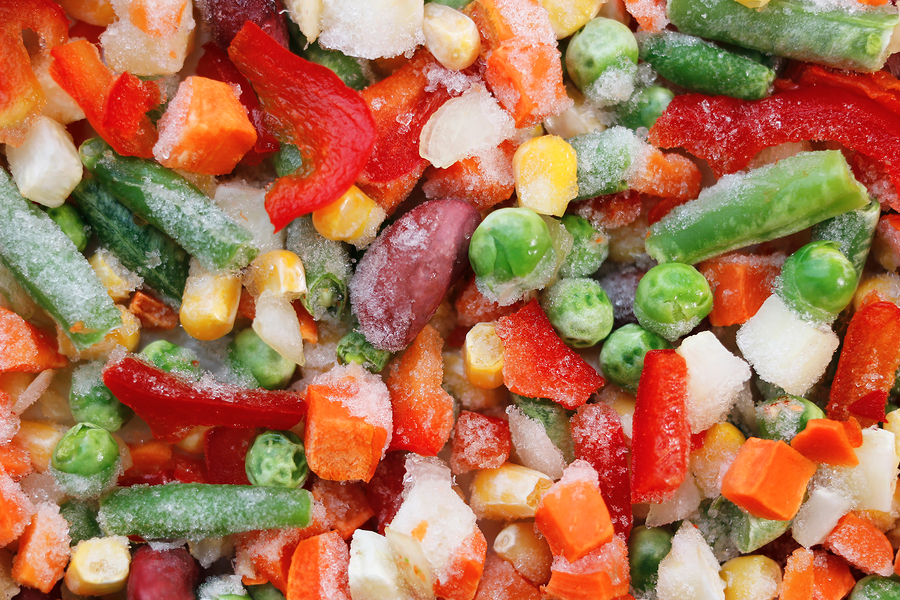Fresh vs Frozen Fruit and Vegetables
Fresh fruits and vegetables are some of the healthiest foods you can eat.
They’re full of vitamins, minerals and antioxidants, all of which can improve health.
Eating more fruits and vegetables may even help protect against heart disease (1).
Fresh produce may not always be available, and frozen varieties are a convenient alternative.
However, their nutritional value may differ.
This article compares the nutrient content of fresh and frozen fruits and vegetables.
Harvest, Processing and Transportation
Most of the fruits and vegetables you buy are harvested by hand, with a smaller amount being harvested by machinery.
However, what happens after that varies between fresh and frozen produce.
Fresh Fruit and Vegetables
Most fresh fruits and vegetables are picked before they are ripe. This allows them time to fully ripen during transportation.
It also gives them less time to develop a full range of vitamins, minerals and natural antioxidants.
In the US, fruits and vegetables may spend anywhere from 3 days to several weeks in transit before arriving at a distribution center.
However, the USDA states that some produce, such as apples and pears, can be stored for up to 12 months under controlled conditions before being sold.
During transportation, fresh produce is generally stored in a chilled, controlled atmosphere and treated with chemicals to prevent spoiling.
Once they reach the supermarket, fruits and vegetables may spend an additional 1–3 days on display. They’re then stored in people’s homes for up to 7 days before being eaten.
Bottom Line: Fresh fruit and vegetables are often picked before they are fully ripe. Transportation and storage can take anywhere from 3 days and up to 12 months for some types of produce.
Frozen Fruit and Vegetables
Fruits and vegetables that will be frozen are generally picked at peak ripeness, when they’re the most nutritious.
Once harvested, the vegetables are often washed, blanched, cut, frozen and packaged within a few hours.
Fruits tend not to undergo blanching, as this can greatly affect their texture.
Instead, they can be treated with ascorbic acid (a form of vitamin C) or added sugar to prevent spoiling.
Usually, no chemicals are added to produce before freezing.
Bottom Line: Frozen fruit and vegetables are generally picked at peak ripeness. They are often washed, blanched, frozen and packaged within a few hours of being harvested.
Some Vitamins Are Lost During Processing of Frozen Produce

Generally speaking, freezing helps retain the nutrient content of fruits and vegetables.
However, some nutrients begin to break down when frozen produce is stored for more than a year (2).
Certain nutrients are also lost during theblanching process. In fact, the greatest loss of nutrients occurs at this time.
Blanching takes place prior to freezing, and involves placing the produce in boiling water for a short time — usually a few minutes.
This kills any harmful bacteria and prevents the loss of flavor, color and texture. Yet it also results in the loss of water-soluble nutrients, such as B-vitamins and vitamin C.
However, this doesn’t apply to frozen fruits, which don’t undergo blanching.
The extent of nutrient loss varies, depending on the type of vegetable and length of blanching. Generally, losses range from 10–80%, with averages around 50% (3, 4).
One study found that blanching reduced water-soluble antioxidant activity in peas by 30%, and in spinach by 50%. Nonetheless, levels remained constant during storage at −4° F, or −20° C (5).
That being said, some research also suggests that frozen produce may retain its antioxidant activity despite the loss of water-soluble vitamins (6, 7).
Bottom Line: Blanching results in a loss of antioxidants, B-vitamins and vitamin C. However, nutrient levels remain fairly stable after freezing.
Nutrients in Both Fresh and Frozen Produce Decline During Storage

Shortly after harvesting, fresh fruits and vegetables start to lose moisture, have a greater risk of spoiling and drop in nutrient value.
One study found a decline in nutrients after 3 days of refrigeration, when values fell to levels below those of frozen varieties. This is most common in soft fruits (8).
The vitamin C in fresh vegetables begins to decline immediately after harvesting and continues to do so during storage (2, 5, 9).
For example, green peas have been shown to lose up to 51% of their vitamin C during the first 24–48 hours after harvesting (9).
In vegetables stored chilled or at room temperature, antioxidant activity declined (5).
However, although vitamin C can be easily lost during storage, antioxidants likecarotenoids and phenolics may actually increase.
This is possibly due to continued ripening and is seen in some fruits (8, 10).
Bottom Line: Certain vitamins and antioxidants begin to decline immediately after harvesting. Therefore, it’s best to eat fresh fruits and vegetables as soon as possible.
Fresh vs Frozen: Which is More Nutritious?

Results from studies that have compared the nutrient content of frozen and fresh produce vary slightly.
This is because some studies use freshly harvested produce, which removes the effects of storage and transport time, while others use produce from supermarkets.
Additionally, differences in processing and measuring methods can influence results.
However, in general, the evidence suggests that freezing can preserve nutrient value, and that the nutritional content of fresh and frozen produce is similar (2, 7, 11).
When studies do report nutrient decreases in some frozen produce, they are generally small (3, 8, 12).
Furthermore, levels of vitamin A, carotenoids, vitamin E, minerals and fiber are similar in fresh and frozen produce. They’re generally not affected by blanching (11).
Studies comparing supermarket produce with frozen varieties — such as peas, green beans, carrots, spinach and broccoli — found the antioxidant activity and nutrient content to be similar (5, 13).
Bottom Line: Frozen produce is nutritionally similar to fresh produce. When nutrient decreases are reported in frozen produce, they’re generally small.
Frozen Produce May Contain More Vitamin C

Frozen produce may contain higher levels of certain nutrients.
This is most commonly seen in studies that compare frozen produce with fresh varieties that have been stored at home for a few days.
For example, frozen peas or spinach may have more vitamin C than supermarket-bought fresh peas or spinach that have been stored at home for several days (13).
For some fruits, freeze drying resulted in higher vitamin C content, when compared to fresh varieties (14).
Additionally, one study suggests that the processes undertaken to freeze fresh produce may increase fiber availability by making it more soluble (3).
Bottom Line: Frozen fruits and vegetables may have higher levels of vitamin C than produce that has been stored at home for several days.
Take Home Message
Freshly picked fruits and vegetables straight from the farm or your own garden are of the highest quality.
However, if you are shopping at the supermarket, frozen produce may be equal to, or in some cases, even more nutritious than fresh varieties.
At the end of the day, frozen fruit and vegetables are a convenient and cost-effective alternative to fresh options.
It’s best to choose a mix of fresh and frozen produce to ensure you get the best range of nutrients.
*Article originally appeared on Authority Nutrition.*












